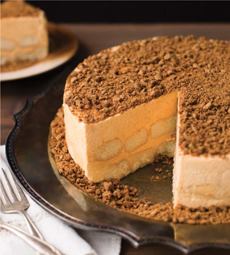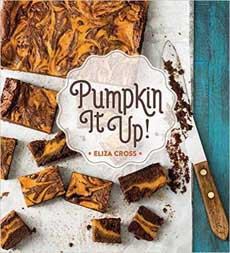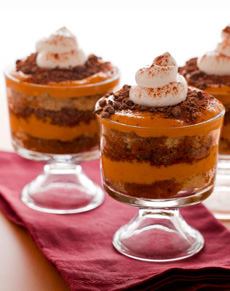RECIPE: Frozen Pumpkin Tiramisu & The History Of Tiramisu
|
Given the popularity of tiramisu in the U.S., we’re surprised we haven’t come across a frozen pumpkin tiramisu before this one. Instead of layering the ingredients in a bowl or pan, this recipe takes the extra step of building it in a springform pan, so it emerges looking like a frozen soufflé. The recipe is courtesy Pumpkin It Up, a book with scores of delicious pumpkin recipes. The history of tiramisu is below. March 21st is National Tiramisu Day, and there’s no reason why you can’t enjoy pumpkin desserts in March! Here are more pumpkin desserts. Ingredients For 8 Servings 1. BEAT the cream and sugar in a large bowl until stiff peaks form. Add the mascarpone, pumpkin, and pumpkin pie spice. Beat just until the filling is smooth. 2. LINE the bottom of a 9 x 2-3/4″ springform pan with 1 package of ladyfingers, breaking and overlapping them to fit. Sprinkle with 2 tablespoons of apple cider. 4. SPREAD half the pumpkin filling over the ladyfingers. Repeat a second layer with the remaining package of ladyfingers, 2 tablespoons of apple cider and the remaining filling. Smooth the top of the tiramisu, cover, and freeze for at least 4 hours or overnight. 5. UNMOLD: Run a knife around the inside of the pan. Release the pan sides and sprinkle the top with crushed gingersnaps. Tiramisu means “pick me up,” a reference to the caffeine from the espresso liqueur and the energy from the eggs and sugar. While there are many variations of the recipe, tiramisu is typically composed of layers of sponge cake or ladyfingers, soaked in espresso liqueur, coffee syrup or marsala, and layered with a mascarpone cheese and custard mixture. It is dusted with cocoa or shaved chocolate. |
 [1] Here’s the frozen pumpkin tiramisu from Pumpkin It Up! (photos #1 and #2 © Gibbs Smith)
|
|
|
For what is a classic Italian dessert, tiramisu is a relatively recent creation. The origins of the dessert are highly contested, but a strong claim has been made that the recipe was invented in the 1960s at the restaurant, Alle Beccherie in Treviso, Italy by pastry chef Loly Linguanotto. The restaurant’s matriarch, Alba Campeol, got the idea for the dessert after the birth of one of her children. Weak in bed, she was brought a zabaglione spiked with coffee, to give her energy. When she returned to work, she and her pastry chef worked on the “pick me up” layered dessert. The original Becchiere recipe did not contain alcohol because it was served to children as well as adults. Today, a good tiramisu is redolent of liqueur or marsala. You can read the full story, plus competing claims to the invention by another Treviso restaurateur, Carminantonio Iannaccone, in this Washington Post article. CHECK OUT WHAT’S HAPPENING ON OUR HOME PAGE, THENIBBLE.COM. |
||




